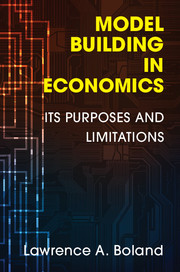Book contents
- Frontmatter
- Dedication
- Contents
- Preface
- Acknowledgements
- Prologue: Model building yesterday versus today
- Part I Theoretical Models
- Part II Empirical Models
- Part III Testing and Models
- 8 On the role and limitations of experimental and behavioural economics
- 9 The logical adequacy of convincing tests of models using empirical data
- 10 The statistical adequacy of convincing tests of models using empirical data
- Part IV Methodological Considerations
- Bibliography
- Name index
- Subject index
10 - The statistical adequacy of convincing tests of models using empirical data
Published online by Cambridge University Press: 05 October 2014
- Frontmatter
- Dedication
- Contents
- Preface
- Acknowledgements
- Prologue: Model building yesterday versus today
- Part I Theoretical Models
- Part II Empirical Models
- Part III Testing and Models
- 8 On the role and limitations of experimental and behavioural economics
- 9 The logical adequacy of convincing tests of models using empirical data
- 10 The statistical adequacy of convincing tests of models using empirical data
- Part IV Methodological Considerations
- Bibliography
- Name index
- Subject index
Summary
‘What is the use of testing, say, the significance of regression coefficients, when maybe, the whole assumption of the linear regression equation is wrong?’ This is just the type of arguments we have discussed.
Trygve Haavelmo [1944, p. 66]Without some idea of the power of statistical tests against interesting alternative hypotheses and/or some metric for evaluating the extent to which the data are inconsistent with a maintained hypothesis formal statistical tests are uninformative.
Science proceeds by falsifying theories and constructing better ones. Falsifications of hypotheses based on overidentifying restrictions … are unenlightening in two senses. First, they provide little insight into whether the reason for the theory’s failure is central to its logical structure or is instead a consequence of auxiliary assumptions made in testing it. … While in principle it would be possible to explore a range of possible assumptions, this type of ‘data mining’ is usually condemned by those who favor formal approaches to empirical work.
Larry Summers [1991, p. 135][S]ome of the methodological problems that contribute to the mountains of untrustworthy evidence could have been avoided if only textbook econometrics paid a bit more attention to some of the key methodological ideas in Haavelmo [1944].
Aris Spanos [2011, §4.3]Chapter 9 was primarily about the logic of testing with exact, singular observations, although I did raise the issues of having to use stochastic data that, of course, are not exact. In this chapter, testing econometrically using statistical data will be the main issue. But, keep in mind that the underlying logical issues remain relevant – often reappearing in the form of the requirements for convincing statistics-based tests – particularly, the ambiguity caused by having to add assumptions.
- Type
- Chapter
- Information
- Model Building in EconomicsIts Purposes and Limitations, pp. 203 - 218Publisher: Cambridge University PressPrint publication year: 2014



